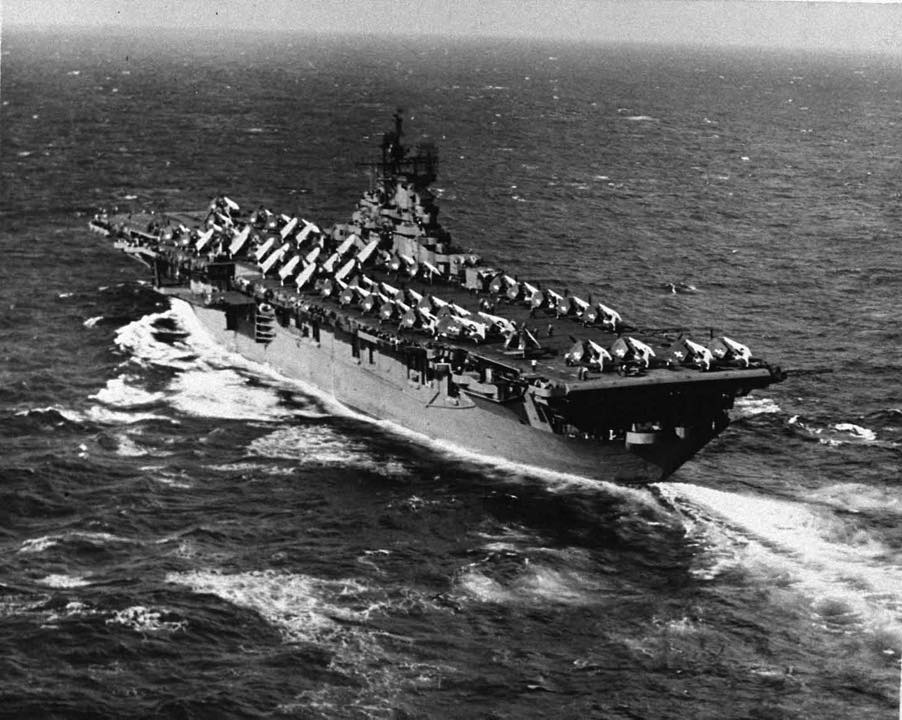USS Intrepid CV-11

The fourth Intrepid (CV-11) was launched on 26 April 1943 by Newport News Shipbuilding & Dry Dock Co., Newport News, Va., sponsored by Mrs. John Howard Hoover, and commissioned on 16 August with Captain Thomas L. Sprague in command.
After training in the Caribbean, Intrepid departed Norfolk on 3 December 1943 for San Francisco and then proceeded to Hawaii, arriving at Pearl Harbor on 10 January. She prepared for the invasion of the Marshall Islands and sortied from Pearl Harbor with carriers Cabot and Essex on 16 January. They raided islands at the northeastern corner of Kwajalein Atoll on 29 January 1944, continuing the attack until 2 February. Intrepid's planes destroyed 83 Japanese planes on Roi and Namur before the first landings on adjacent islets on 31 January. After securing Ennuebing Island, marines set up artillery to support their assault on Roi.
Intrepid then headed for Truk, where three fast carrier groups arrived undetected at daybreak on 17 February, sinking two destroyers and 200,000 tons of merchant shipping in two days of nearly continuous attacks. The night of 17 February, an aerial torpedo struck Intrepid's starboard quarter, jamming her rudder. Captain Sprague kept her on course using improvised methods until strong winds forced her back. A makeshift sail fashioned from hatch covers and scrap canvas allowed her to maintain course to Pearl Harbor, where she arrived on 24 February 1944 for temporary repairs. After further repairs on the West Coast, she returned to operations out of Pearl Harbor and then to the Marshalls.
Intrepid's planes struck Japanese positions in the Palaus on 6 and 7 September and then moved to airfields in the southern Philippines. After supporting marines in the Palaus, she struck throughout the Philippines, Okinawa, and Formosa, neutralizing Japanese air threats to Leyte.
During the Battle for Leyte Gulf, Intrepid's planes helped sink the battleship Musashi and damaged other Japanese ships. On 30 October, a kamikaze crashed into Intrepid's port gun tub, killing 10 men. She resumed operations after quick repairs. On 25 November, two kamikazes hit Intrepid, killing 11. She sailed to San Francisco for repairs, returning to action in mid-February 1945.
Intrepid supported strikes against airfields on Kyushu, Japan, in March 1945. On 16 April, a kamikaze crashed into her flight deck, killing eight. She returned to San Francisco for repairs, arriving on 19 May. Intrepid resumed operations in June, supporting the occupation of Japan after receiving the cease-offensive order on 15 August.
After the war, Intrepid decommissioned in March 1947 and joined the Pacific Reserve Fleet. She recommissioned in 1952, underwent modernization, and served in the Atlantic and Mediterranean, earning the Battle Efficiency "E" for antisubmarine warfare.
Intrepid participated in several significant missions, including the recovery of astronauts from Project Mercury and Gemini missions. She underwent a major overhaul in 1965 and returned to action in Vietnam in 1966, earning commendations for her performance.
Intrepid was struck from the Naval Register in 1980 and now serves as the Intrepid Sea, Air & Space Museum in New York City.
